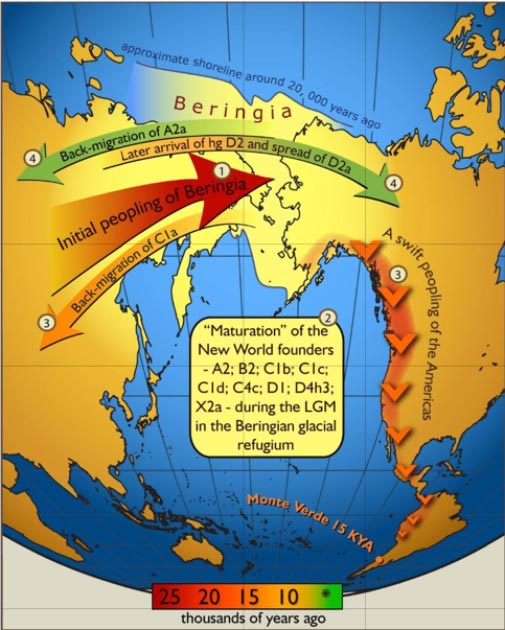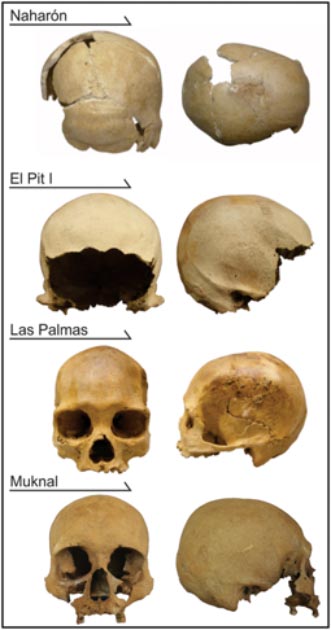
First Americans Were More Diverse Than Thought
Scientists are claiming current theories “over-simplify” how the Americas were populated.
Many of us were once taught that the Americas were void of humans until around 13,000 years ago. Authors like Graham Hancock in his new book take the other extreme and try to convince us, without any substantial evidence, that the last great landmass was first peopled more than 130,000 years ago.
Most archaeologists would agree that when ocean levels were lower during the last Ice Age paleolithic people crossed Beringia, the land bridge that connected Siberia to Alaska, and entered the New World and that the earliest South Americans ventured south from North America. However, a new study has shown early humans in North and Central America displayed more diversity in craniofacial morphology than had been expected.

2007 map of gene flow in and out of Beringia, according to human mitochondrial DNA haplogroups. Colors of the arrows correspond to approximate timing of the events and are decoded in the colored time bar. (Image: PLoS One / CC BY 2.5)
Diversity Of American Settlers Has Been Overlooked, Until Now…
Professor Mark Hubbe from Ohio State University, Alejandro Terrazas Mata from National Autonomous University of Mexico and colleagues reported in the journal PLoS ONE on Wednesday that four paleo-Mexican skulls found in a vast cave system on the coast of Quintana Roo, in the vicinity of the town of Tulum demonstrate “unexpectedly high diversity” suggesting mainstream theories on the history of the population of the Americas is much too “simplistic”.
Professor Hubbe told Haaretz that the initial populations of North America were more morphologically diverse than had been assumed, and that this diversity spread into Central America.
However, typical features of early South Americans are a narrow, elongated skull with a projecting face and relatively short orbits, and all early remains show strong affinity with Australian and African groups. This observation, according to Dr. Hubbe, demonstrates that they had retained the “ancestral morphological pattern of modern humans” and as such early Mexicans are more diverse.

The early Quintana Roo specimens analyzed in this study. (© 2020 Hubbe et al. PLoS ONE/ CC BY 4.0)
Studying The Oldest Human Remains In The Americas
Back in high school I was taught that Clovis culture was named after distinctive stone tools found near to Clovis, New Mexico, in the 1920s, and that these people had arrived in the Americas roughly 13,200 to 12,900 years ago. What’s more, I was told these people were the ancestors of most of the indigenous cultures of the Americas. This idea has all but died and so too has the dogmatic assumption that a single migration wave arrived in the Americas. Now, due to the new study of four skeletons of people who lived approximately 14,000 to 8,000 years ago, it’s all change again.
The four human remains were discovered in a complex cave system situated along the coast of Quintana Roo and they are among the earliest human remains ever found in the Americas. Hubbe and the team of researchers checked the morphology of the ancient Quintana Roo skulls against a worldwide dataset of living people today and the results are set to upset the apple cart.
- Did the Denisovans Walk to North America?
- 16,700-Year-Old Tools Found in Texas Change Known History of North America
- A Mexican Underwater Cave System is the Largest in the World…and Filled with Archaeological Value
Tracking America’s Earliest Settlers
The oldest skull belonged to a young woman who lived almost 14,000 years ago, and features were found resembling arctic North Americans in Greenland and Alaska. The second-oldest skull belonged to a young male which shared similarities with modern European skull shapes, the third skull showed associations with paleo-Brazilian and paleo-Japanese groups and the fourth showed commonalities with arctic populations, as well as having modern South American features.
These new findings do not suggest ancient Europeans, Africans and Polynesians were sailing to the Americas in prehistory, but just how highly diverse the early colonizers of North and Central America actually were, and that only some population groups dispersed into South America, resulting in its diminished diversity. The observed African and Melanesian features are explained as “retention of ancestral human features, which was subsequently lost” and does not mean they are descendants from those people, Hubbe wrote in the paper.
The new study is not so much about “who” the first settlers in the Americas were, but more so about what happened to these people after they got there, and the scientists point out that they did not just move south following these “long and linear arrows we draw on maps”. Dr. Hubbe concluded that the Americas’ occupation is more complex than had been thought up till now and he refers to the current archaeological and anthropological models as being “far are too simplistic”.
Top image: Original position of the skeletal remains inside submerged cave of Muknal. Source: Jerónimo Avilés /© 2020 Hubbe et al CC BY 4.0
By Ashley Cowie
















Comments
So, they have evidence of not only Asian, but European and African features in old remains, and suddenly it’s not about where these people came from? How interesting….
LGE
The assumption is made that there was no immigration direct from Africa or even from Australia. Scientists have done this in the past and time has proved them to be totally wrong. Finding the perfect skull of an Australian Aboriginal women in South America was quickly shoved under the carpet.
Sometimes I wonder if this subject has been simplified on purpose; as if some people have been trying to hide the long past of first Americans. I don't know if politics has anything to do with it.